Diana Kupke Writes

Roses from the Heart
Rose Hunt, a descendant of convicts, had no idea a project she became involved in during 2017 would consume two years of her life. Over a two year period she made 43 bonnets for the Roses of the Heart project.
Roses of the Heart is a memorial to all the 25,566 women who were sentenced to transportation to Australia between 1788 and 1853. A wide variety of cloth bonnets, decorated in various ways, were made to commemorate these female convicts. Each bonnet was embroidered with the name of a convict, the name of the vessel on which she travelled to Australia, and the date she began her life as a convict in Australia.
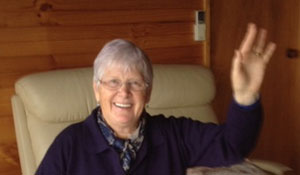
Rose Hunt
The project, which was begun in 2007 and designed by Dr Christina Henri, appealed to Rose as she had three female convicts in her background, Ann White, Catherine Jones, and Ann Parker. Ann White is her four times great grandmother on her father's side and Ann is also on my father's direct line.
"It was a very creative time of my life and took two full years – sometimes I was up at four in the morning when I thought of something and often I did not go to bed until one a.m."
The creation of the bonnets was a very personal journey for Rose who said the stories for each bonnet reflected the relationship she held with each family member or friend. Some of the bonnets reflect places including Norfolk Island and Tasmania, and some reflect the person or times in which they lived.
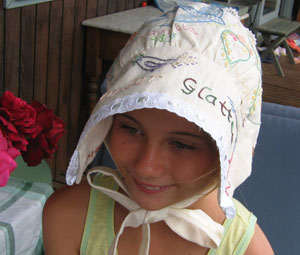
Above is the bonnet for Ann Parker, a convict in Australia.
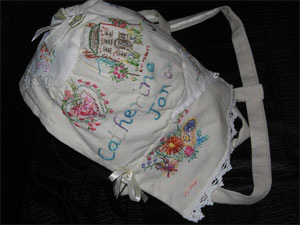
Above is the bonnet for convict Catherine Jones.
"Each bonnet has some roses and hearts embroidered on it and then I have used icons and pictures to illustrate the relationship with our present day family. Jack is the eldest of my sister Jane’s grand children and on his bonnet he has icons for all his second cousins- all children have my father Harry Hunt as their common great grandfather.
"Harry's relationship to the convict women- Ann White was his paternal great great grandmother, Catherine Jones (who supposedly stole two shillings from her employer), and Ann Parker who lived on the streets in London, They all were sent to Norfolk Isand.
"All the embroidered icons have a meaning."
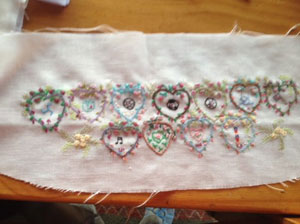
Above the icons for each of Harry Hunt's great grandchildren.
During her work on the bonnets, Rose was overwhelmed by layers of love, compassion, sadness, and joy. There were also amusing incidents and emotions from others in the family who helped design the bonnets, particularly by Rose's grandchildren.
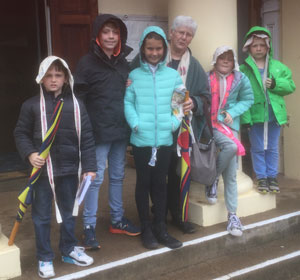
Above is Rose with her grandchildren.
Rose has compiled a collection of photographs which will explain how the bonnets were made. Making the bonnets.
Below is Harry Hunt's bonnet.
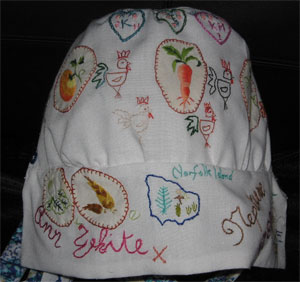
In the 1970s, long before the advent of the world wide web, Rose's father, Harry Hunt, worked tirelessly to discover the Kennedy Murray story, (Murray was married to Ann Parker), and over the years he found about 3000 descendants.
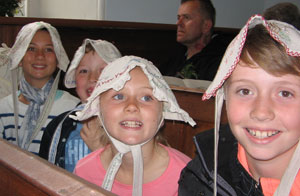
Above, Harry Hunt's great grandchildren wearing bonnets made by grandmother, Rose.
In her quest to find out more about her family history, Rose has visited Norfolk Island to see where Murray lived, and she also visited Evandale in Tasmania where Murray lived out his declining years.
Rose took the bonnets to Tasmania where they were given to Dr Christina Henri to be part of her exhibitions both in Australia and overseas.
Rose said all the bonnets were made from recycled or stashed materials except for some new stranded cottons provided by friends.
"The bonnets were made from linen or cotton and some linings were made from silk. I sourced stranded thread, lace and trimmings, from friends and opp shops from Queenscliff to Portland."
Here is a selection of bonnets. Rose Hunt's bonnets.
Over the years Christina Henri has taken selections of the bonnets to a number of conferences around the world and some bonnets are also displayed in Tasmania at the Cascades Female Factory Historic Site.
Rose did not stop sewing after she completed the bonnets and in 2019 she made 60 possum pouches for the droughts and then the bushfire survivors.
Here are other pages about convicts.
Links to other convicts associated with my family
Links to surnames associated with my family
- Ancestral Circle
- Basan
- Canet
- Dudley
- Val Dudley's Story
- Hovey
- Lyons
- Mann
- Marks
- Montgomery
- Nell's Story
- Sandilands
- George Canet's Sandilands' Story
- Streater/Streeter
- Wilkinson